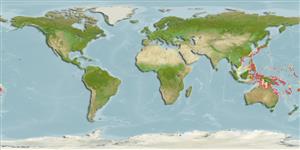Actinopterygii (ray-finned fishes) >
Perciformes (Perch-likes) >
Gobiidae (Gobies) > Gobiinae
Etymology: Amblyeleotris: Greek, amblys = darkness + The name of a Nile fish, eleotris (Ref. 45335).
Environment / Climate / Range
Ecology
Marine; demersal; depth range 20 - 35 m (Ref. 90102). Subtropical, preferred ?
Western Pacific: Wakayama Prefecture, Chichijima, Okinawajima, and along the east coast of northern Australia.
Size / Weight / Age
Maturity: Lm ? range ? - ? cm
Max length : 10.0 cm SL male/unsexed; (Ref. 48637)
Dorsal
spines
(total): 7;
Dorsal
soft rays
(total): 13-14;
Anal
spines: 1;
Anal
soft rays: 13 - 14. Characterized by yellowish color on back grading to white on lower half; head and body with five broad brown bars; numerous blue spots on head, in pale spaces between brown bars; caudal fin with broad white upper margin; dorsal fin with blue and yellow basal stripes; pelvic fins united by low membrane at base of fins; absence of median predorsal scales; side of nape with scales extending forward to above middle of preopercle; longitudinal scale series 80-94; greatest depth of body 5.2-5.8 in SL; lanceolate caudal fin, longer than head length (Ref. 90102).
Inhabits clear coastal sand slopes, but appears to be uncommon in Indonesia (Ref. 48637). Found in sand bottoms in 20-35 m (Ref. 90102).
Life cycle and mating behavior
Maturity | Reproduction | Spawning | Eggs | Fecundity | Larvae
Masuda, H., K. Amaoka, C. Araga, T. Uyeno and T. Yoshino, 1984. The fishes of the Japanese Archipelago. Vol. 1. Tokai University Press, Tokyo, Japan. 437 p. (text). (Ref. 559)
IUCN Red List Status (Ref. 115185)
CITES (Ref. 94142)
Not Evaluated
Threat to humans
Harmless
Human uses
More information
Common namesSynonymsMetabolismPredatorsEcotoxicologyReproductionMaturitySpawningFecundityEggsEgg development
ReferencesAquacultureAquaculture profileStrainsGeneticsAllele frequenciesHeritabilityDiseasesProcessingMass conversion
Tools
Special reports
Download XML
Internet sources
Estimates of some properties based on models
Phylogenetic diversity index (Ref.
82805): PD
50 = 0.5000 [Uniqueness, from 0.5 = low to 2.0 = high].
Bayesian length-weight: a=0.00631 (0.00286 - 0.01390), b=3.08 (2.90 - 3.26), in cm Total Length, based on LWR estimates for this (Sub)family-body shape (Ref.
93245).
Trophic Level (Ref.
69278): 3.4 ±0.3 se; Based on size and trophs of closest relatives
Resilience (Ref.
69278): High, minimum population doubling time less than 15 months (Preliminary K or Fecundity.).
Vulnerability (Ref.
59153): Low to moderate vulnerability (26 of 100) .
